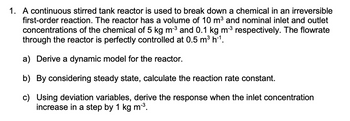
Introduction to Chemical Engineering Thermodynamics
8th Edition
ISBN: 9781259696527
Author: J.M. Smith Termodinamica en ingenieria quimica, Hendrick C Van Ness, Michael Abbott, Mark Swihart
Publisher: McGraw-Hill Education
expand_more
expand_more
format_list_bulleted
Question
steos on how to reach answer for C
feedback attached

Transcribed Image Text:1. A continuous stirred tank reactor is used to break down a chemical in an irreversible
first-order reaction. The reactor has a volume of 10 m³ and nominal inlet and outlet
concentrations of the chemical of 5 kg m-³ and 0.1 kg m-³ respectively. The flowrate
through the reactor is perfectly controlled at 0.5 m³ h-¹.
a) Derive a dynamic model for the reactor.
b) By considering steady state, calculate the reaction rate constant.
c) Using deviation variables, derive the response when the inlet concentration
increase in a step by 1 kg m-³.
![1. Most managed this question well:
a) Derive a dynamic model for the reactor.
The model is the same as the one we found during the lecture.
b) By considering steady state, calculate the reaction rate constant.
Set the accumulation term to zero for steady-state. Sub in the steady-state
values of concentration that were provided and rearrange for k. Pay attention
that the units of k are consistent with the order of reaction.
Ꮎ
=
V
F
= 20 h k =
c* (t)
1 Cin - Css
Ꮎ Css
c) Using deviation variables, derive the response when the inlet concentration
increase in a step by 1 kg m-³.
=
Again the solution is the one we obtained during the lecture, although in this case
with specific numerical values for the time constant and steady-state gain.
1
50
4.9
0.1 × 20
= 2.45 h-¹
[1 - exp(-2.5t)]](https://content.bartleby.com/qna-images/question/de55ad6b-27eb-44c5-bca1-afdb32f2dfc7/adcfd555-dd9e-4c6a-8562-92db8c88ccbf/ouzt4ie_thumbnail.png)
Transcribed Image Text:1. Most managed this question well:
a) Derive a dynamic model for the reactor.
The model is the same as the one we found during the lecture.
b) By considering steady state, calculate the reaction rate constant.
Set the accumulation term to zero for steady-state. Sub in the steady-state
values of concentration that were provided and rearrange for k. Pay attention
that the units of k are consistent with the order of reaction.
Ꮎ
=
V
F
= 20 h k =
c* (t)
1 Cin - Css
Ꮎ Css
c) Using deviation variables, derive the response when the inlet concentration
increase in a step by 1 kg m-³.
=
Again the solution is the one we obtained during the lecture, although in this case
with specific numerical values for the time constant and steady-state gain.
1
50
4.9
0.1 × 20
= 2.45 h-¹
[1 - exp(-2.5t)]
Expert Solution
This question has been solved!
Explore an expertly crafted, step-by-step solution for a thorough understanding of key concepts.
Step by stepSolved in 4 steps with 24 images

Knowledge Booster
Similar questions
arrow_back_ios
arrow_forward_ios
Recommended textbooks for you
 Introduction to Chemical Engineering Thermodynami...Chemical EngineeringISBN:9781259696527Author:J.M. Smith Termodinamica en ingenieria quimica, Hendrick C Van Ness, Michael Abbott, Mark SwihartPublisher:McGraw-Hill Education
Introduction to Chemical Engineering Thermodynami...Chemical EngineeringISBN:9781259696527Author:J.M. Smith Termodinamica en ingenieria quimica, Hendrick C Van Ness, Michael Abbott, Mark SwihartPublisher:McGraw-Hill Education Elementary Principles of Chemical Processes, Bind...Chemical EngineeringISBN:9781118431221Author:Richard M. Felder, Ronald W. Rousseau, Lisa G. BullardPublisher:WILEY
Elementary Principles of Chemical Processes, Bind...Chemical EngineeringISBN:9781118431221Author:Richard M. Felder, Ronald W. Rousseau, Lisa G. BullardPublisher:WILEY Elements of Chemical Reaction Engineering (5th Ed...Chemical EngineeringISBN:9780133887518Author:H. Scott FoglerPublisher:Prentice Hall
Elements of Chemical Reaction Engineering (5th Ed...Chemical EngineeringISBN:9780133887518Author:H. Scott FoglerPublisher:Prentice Hall
 Industrial Plastics: Theory and ApplicationsChemical EngineeringISBN:9781285061238Author:Lokensgard, ErikPublisher:Delmar Cengage Learning
Industrial Plastics: Theory and ApplicationsChemical EngineeringISBN:9781285061238Author:Lokensgard, ErikPublisher:Delmar Cengage Learning Unit Operations of Chemical EngineeringChemical EngineeringISBN:9780072848236Author:Warren McCabe, Julian C. Smith, Peter HarriottPublisher:McGraw-Hill Companies, The
Unit Operations of Chemical EngineeringChemical EngineeringISBN:9780072848236Author:Warren McCabe, Julian C. Smith, Peter HarriottPublisher:McGraw-Hill Companies, The

Introduction to Chemical Engineering Thermodynami...
Chemical Engineering
ISBN:9781259696527
Author:J.M. Smith Termodinamica en ingenieria quimica, Hendrick C Van Ness, Michael Abbott, Mark Swihart
Publisher:McGraw-Hill Education

Elementary Principles of Chemical Processes, Bind...
Chemical Engineering
ISBN:9781118431221
Author:Richard M. Felder, Ronald W. Rousseau, Lisa G. Bullard
Publisher:WILEY

Elements of Chemical Reaction Engineering (5th Ed...
Chemical Engineering
ISBN:9780133887518
Author:H. Scott Fogler
Publisher:Prentice Hall


Industrial Plastics: Theory and Applications
Chemical Engineering
ISBN:9781285061238
Author:Lokensgard, Erik
Publisher:Delmar Cengage Learning

Unit Operations of Chemical Engineering
Chemical Engineering
ISBN:9780072848236
Author:Warren McCabe, Julian C. Smith, Peter Harriott
Publisher:McGraw-Hill Companies, The